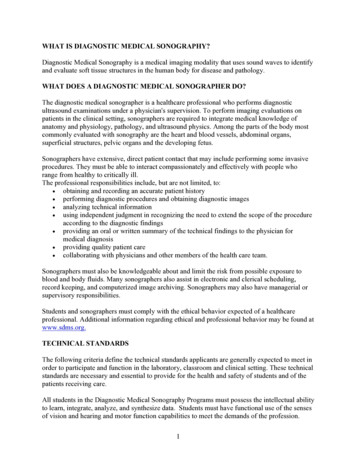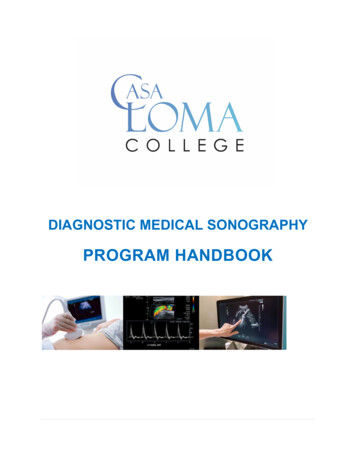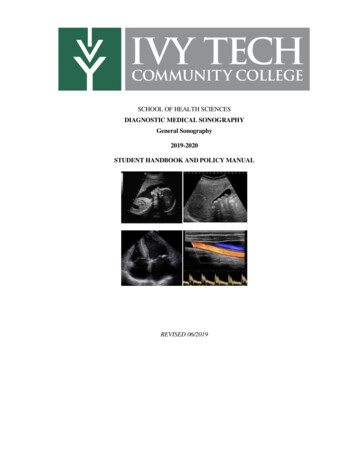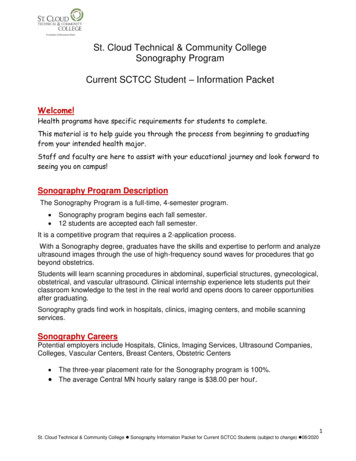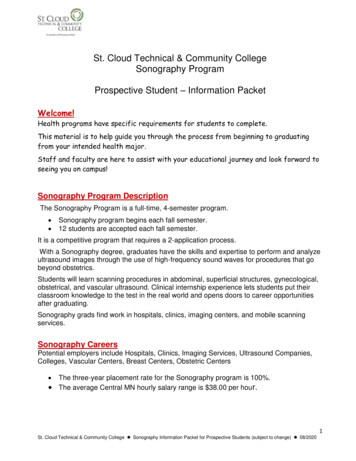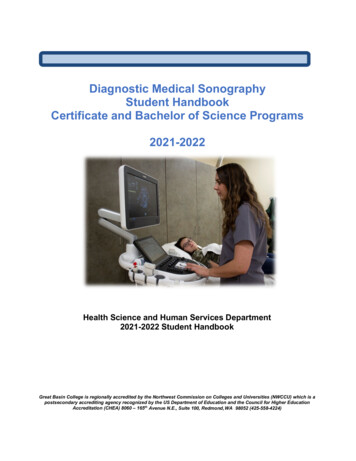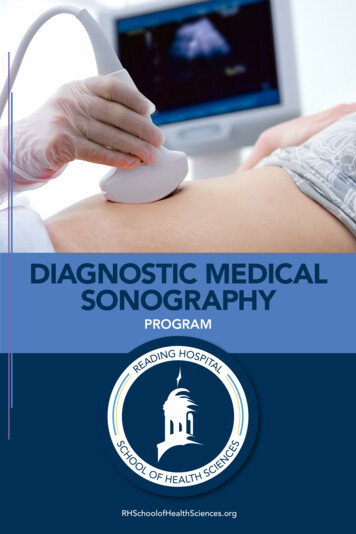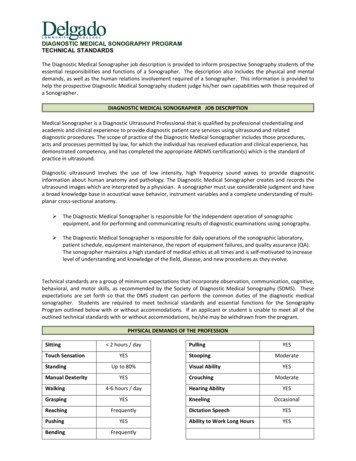
Transcription
DIAGNOSTIC MEDICAL SONOGRAPHY PROGRAMTECHNICAL STANDARDSThe Diagnostic Medical Sonographer job description is provided to inform prospective Sonography students of theessential responsibilities and functions of a Sonographer. The description also includes the physical and mentaldemands, as well as the human relations involvement required of a Sonographer. This information is provided tohelp the prospective Diagnostic Medical Sonography student judge his/her own capabilities with those required ofa Sonographer.DIAGNOSTIC MEDICAL SONOGRAPHER JOB DESCRIPTIONMedical Sonographer is a Diagnostic Ultrasound Professional that is qualified by professional credentialing andacademic and clinical experience to provide diagnostic patient care services using ultrasound and relateddiagnostic procedures. The scope of practice of the Diagnostic Medical Sonographer includes those procedures,acts and processes permitted by law, for which the individual has received education and clinical experience, hasdemonstrated competency, and has completed the appropriate ARDMS certification(s) which is the standard ofpractice in ultrasound.Diagnostic ultrasound involves the use of low intensity, high frequency sound waves to provide diagnosticinformation about human anatomy and pathology. The Diagnostic Medical Sonographer creates and records theultrasound images which are interpreted by a physician. A sonographer must use considerable judgment and havea broad knowledge base in acoustical wave behavior, instrument variables and a complete understanding of multiplanar cross-sectional anatomy. The Diagnostic Medical Sonographer is responsible for the independent operation of sonographicequipment, and for performing and communicating results of diagnostic examinations using sonography. The Diagnostic Medical Sonographer is responsible for daily operations of the sonographic laboratory,patient schedule, equipment maintenance, the report of equipment failures, and quality assurance (QA).The sonographer maintains a high standard of medical ethics at all times and is self-motivated to increaselevel of understanding and knowledge of the field, disease, and new procedures as they evolve.Technical standards are a group of minimum expectations that incorporate observation, communication, cognitive,behavioral, and motor skills, as recommended by the Society of Diagnostic Medical Sonography (SDMS). Theseexpectations are set forth so that the DMS student can perform the common duties of the diagnostic medicalsonographer. Students are required to meet technical standards and essential functions for the SonographyProgram outlined below with or without accommodations. If an applicant or student is unable to meet all of theoutlined technical standards with or without accommodations, he/she may be withdrawn from the program.PHYSICAL DEMANDS OF THE PROFESSIONSittingTouch SensationStandingManual Dexterity 2 hours / dayYESUp to 80%YESWalking4-6 hours / requentlyPullingStoopingVisual AbilityCrouchingHearing Dictation SpeechYESAbility to Work Long HoursYES
The following technical standards and essential functions outline reasonable expectations of a student in theSonography Program for the performance of common sonographic imaging functions. The sonography student mustbe able to apply the knowledge and skills necessary to employ prudent and safe use of ultrasound (Sonography ALARAprinciple) and function in a variety of classroom, lab, and/or clinical situations while completing the essentialcompetencies of sonographic imaging. These requirements apply for the purpose of admission and continuation inthe program.PERFORMANCE RESPONSIBILITIES AND ESSENTIAL FUNCTIONS - TECHNICAL RESPONSIBILITIESThe Sonographer should be able to: Examine ultrasound exam requisitions to verify the accuracy and completeness of information. Upon request for when appropriate, retrieve radiographic and ultrasonic patient films and records. Select appropriate instrumentation for each type of exam and select appropriate instrumentation changesnecessary to adjust to patient variables. Exercise good judgment when performing ultrasound procedures. Recognize emergent patient conditions and respond accordingly. Follow scan protocols that are required by each physician who interprets ultrasound exams. Make accurate measurements off of ultrasound images and utilize computer program to calculate additionaldata from measurements. Recognize and differentiate artifacts from normal or pathological processes. When pathology is imaged, modify scan protocol to include additional techniques and images of the pathologyand areas where related pathology might exist. Recognize safety hazards. Recognize and report any change in the performance of ultrasound or other equipment used to perform anultrasound exam. Perform periodic quality assurance tests on the ultrasound instrumentation and maintain records of the tests. Recognize when equipment quality assurance tests indicate that the physician and other hospital personnelshould be notified. Maintain order and cleanliness of equipment and ultrasound exam area. Provide information about diagnostic ultrasound to patients, their relatives and staff.ADMINISTRATIVE AND RECORD KEEPINGThe Sonographer should be able to: Schedule patient exams and procedures. Maintain all necessary departmental and hospital records (may require use of computer systems). Maintain an adequate inventory of necessary supplies. Maintain records of all equipment quality assurance tests.OBSERVATION STANDARDAbility to participate actively in all demonstrations, laboratory exercise, and clinical experiences in the professionalprogram component and to assess and comprehend the condition of all patients assigned to the student forexamination, diagnosis and treatment.Such observation and information usually require functional use of visual, auditory, and somatic sensations. Distinguish gray scale and color distinctions on live, simulated, and recorded images while simultaneouslyviewing the ultrasound control panel in low light settings required for sonographic imaging. Recognize normal and pathologic sonographic characteristics of organs, tissues, and blood flow. Observe sonographers demonstrating scanning skills and patient manipulations. Observe patients both near and far in an environment with limited lighting. Recognize, interpret, and respond to facial expressions and body language. Monitor patient physical and mental status during the scan. Recognize and respond to soft voices or voices under protective garb.
Distinguish audible sounds from both the patient and the ultrasound unit.Adequately view sonograms, have the ability to perceive small details as well as discriminate subtledifferences.COMMUNICATION SKILLS STANDARDAbility to interact and communicate effectively in English using verbal, non-verbal and written formats with faculty,other students, patients, families and all members of the healthcare team. (including telephone). Elicits and transmits information to patients, staff, fellow students, instructors, and other members of thehealthcare team. Comprehend and interpret verbal and written communication in both the academic and clinical settings. Obtain relevant patient clinical information, responds to questions, interpret physician’s orders andcommunicates sonographic findings to interpreting physician in both verbal and written formats. Instruct patients prior to, during, and after ultrasound exams in order to relieve patient anxiety, maintainpatient cooperation, achieve proper patient positioning, and insure that patient comfort is maintained asmuch as possible. Demonstrate sensitivity towards individuals from diverse backgrounds. Hear and communicate instructions and explanations to patients in a manner displaying compassion andempathy. Recognize and respond to an urgent or emergency situations. Read and analyze patient medical records (EMR/EHR) and exam requisition for pertinent information.EQUIPMENTInstrumentation that the sonographer uses includes (but it not limited to) the following: Various stationary and portable ultrasound instruments including: M-mode B-Mode Doppler Transabdominal Transducers Endovaginal Transducers Endorectal Transducers Computers / PACs Systems Digital storage devices Video recorders / printers QA phantomsMOTOR SKILLS STANDARDSufficient motor ability to execute the movement and skills required for safe and effective and emergencytreatment. Abilities required of a student include gross and fine muscular movements, equilibrium, strength forthe handling of patients, self, and equipment. The ability to exert muscle force repeatedly or continuously overtime to lift some patients, move heavyequipment on wheels (up to approximately 500 lbs.), and patients in wheelchairs and stretchers. The ability to exert muscle force repeatedly and continuously over time (including walking, standing or beingupright continuously for 8-12 hours). Be able to lift 50 lbs. routinely without assistance. Ensures proper and safe patient positioning, movement of the ultrasound unit and other equipment in allsettings. The ability to apply physical exertion over long periods of time and application of trunk strength to push andpull, bend and stoop. The ability to exert muscle force and apply trunk strength to perform sonographic exams while sitting orstanding.
Full use of hands, wrists, and shoulders (arm-hand steadiness, control precision, dynamic flexibility, extentflexibility, finger dexterity, quickly move arms). Ability to maintain adequate probe pressure (exert up to 40lbs. of continuous pressure) necessary to acquire ultrasound images.Maintain prolonged arm positions needed for scanning (stamina, arm-hand steadiness).Demonstrate manual dexterity and fine motor movements to manipulate the ultrasound transducer andcontrol panel simultaneously while achieving the diagnostic objective of the scan/examination (controlprecision, dynamic flexibility, extent flexibility, finger dexterity, and multi-limb coordination).Rapidly respond to emergency signals and alarms.View ultrasound monitors for hours at a time.Lift and assist patients (with assistance) onto and off exam surfaces.Perform ultrasound exams in a sterile environment (when required).Move independently about the department, hospital, clinical facility, and/or patient rooms in an expedientmanner.Maintain hand-eye coordination in order to always be aware of image scan plane and its orientation to thepatient.The ability to reach up to six feet above the floor, and ability to reach frequently.AUDITORY ABILITYSonographers should possess the following auditory abilities: Hear auditory signals from monitors and console control panels. Hear and properly react to building Public Announcement systems. Hear and differentiate frequencies from speakers during Doppler exams.INTELLECTUAL STANDARDAbility to collect, interpret, and integrate information and make decisions. The abilities required of a student includemeasurements, calculations, reasoning, analysis, and synthesis. Conceptual, integrative, and quantitative abilitiesare also required. A student must have these abilities to accurately perform sonographic technique to producequality sonograms. Read, comprehend, retain and apply relevant information in textbooks, medical records, and professionalliterature. Apply knowledge and learning to new situations and problem-solving scenarios instituting solutions andassessing outcomes. Collect and evaluate pertinent patient data and information to determine relevance to the requested exam.Integrate medical history and current symptoms to determine the appropriate protocol and tailor theultrasound exam to the patient’s needs. Determine contraindications, insufficient patient preparation, assess patient’s physical and/or mentalcondition that will affect the patient’s ability to tolerate the sonographic procedure. Measure, calculate reason, analyze, and synthesize sonographic information during the performance of eachexam and during the acquisition of each image. Organize and accurately perform the individual steps in a sonographic procedure in the proper sequence. Process, respond, and draw conclusions from sonographic images, recognize and correct inconsistencies,correlate clinical information with sonographic findings and make specific assessments and determinationsbased on those findings and established criteria. Uses professional judgement to adapt the protocol for the patient’s condition to optimize exam results. Notifies supervising physician(s) if emergency care is needed based on the sonographic findings and patientcondition. Demonstrates effective clinical decision-making to perform sonographic scans/exams in all clinical settingswithin required time frames and in compliance with the Sonography ALARA principle. Understand and interpret written and verbal instructions. Comprehend multi-dimensional and spatial relationships of anatomy in order to establish a three-dimensionalconcept.
BEHAVORIAL AND SOCIAL ATTRIBUTESPossess the emotional health and stability required for full utilization of the sonographer/student’s intellectualabilities, the exercise of good judgment, the prompt completion of all academic and patient care responsibilitiesand the development of mature, sensitive, and effective relationships with patients and other members of thehealth care team.Possess the ability to tolerate taxing workloads, function effectively under stress, adapt to changing environments,display flexibility and learn to function in the face of uncertainties inherent in clinical settings with patients.Possess compassion, integrity, motivation, and concern for others.Possess the ability to demonstrate professional behaviors and a strong work ethic. Manage fast paced and heavy didactic and clinical schedules and deadlines. Perform ultrasound exams infast paced clinical settings and during clinical situations including emergency situations.Maintain focus and remain on task to function effectively during instruction and performance of sonogramsunder stressful conditions while exercising appropriate judgement. Responds to rapidly changing andunpredictable circumstances.Complete daily workload including technically difficult patients, emergency exams, and added exams withinallotted time frames in compliance with the Sonographic ALARA principle.Demonstrate integrity, compassion, interest, motivation, and appropriate interpersonal skills.Manage personal life and obligations to maintain focus on didactic and clinical course requirements;maintain focus on the patient at all times and in all settings.Accept and utilize scanning critiques, self-assessment, and feedback to improve sonographic knowledge andskills.Collaborate with classmates to develop professional qualities and scanning skills.Demonstrate a stable professional demeanor in all settings and with all individuals; manage emotions andresponses to evaluations and feedback.Comply with the Sonographer Scope of Practice and Clinical Practice Standards (Society of DiagnosticMedical Sonography: www.sdms.org).Display flexibility and adaptability.Be able to be in close contact with patients (pediatric, geriatric, pregnant, acutely ill, contagious).Understand the implication of noncompliance with the legal standards.Learn by a variety of methods which includes, classroom, lab, groups, individual, and computer.ETHICAL AND LEGAL STANDARDSStudents must be able to understand the basis and content of both general and medical ethics. The student mustpossess attributes that include compassion, altruism, integrity, responsibility, and tolerance. Students must beable to recognize limitations in their knowledge, skills and abilities and to seek appropriate assistance with theiridentified limitations.RESOURCESThe sonographer should comply with: Sonographer Code of Ethics Scope of Practice and Clinical StandardsSociety of Diagnostic Medical Sonographywww.sdms.orgAmerican Registry of Diagnostic Medical Sonographywww.ardms.orgRevised 6/2021
behavioral, and motor skills, as recommended by the Society of Diagnostic Medical Sonography (SDMS). These expectations are set forth so that the DMS student can perform the common duties of the diagnostic medical sonographer. Students are required to meet technical standards and essential functions for the Sonography
